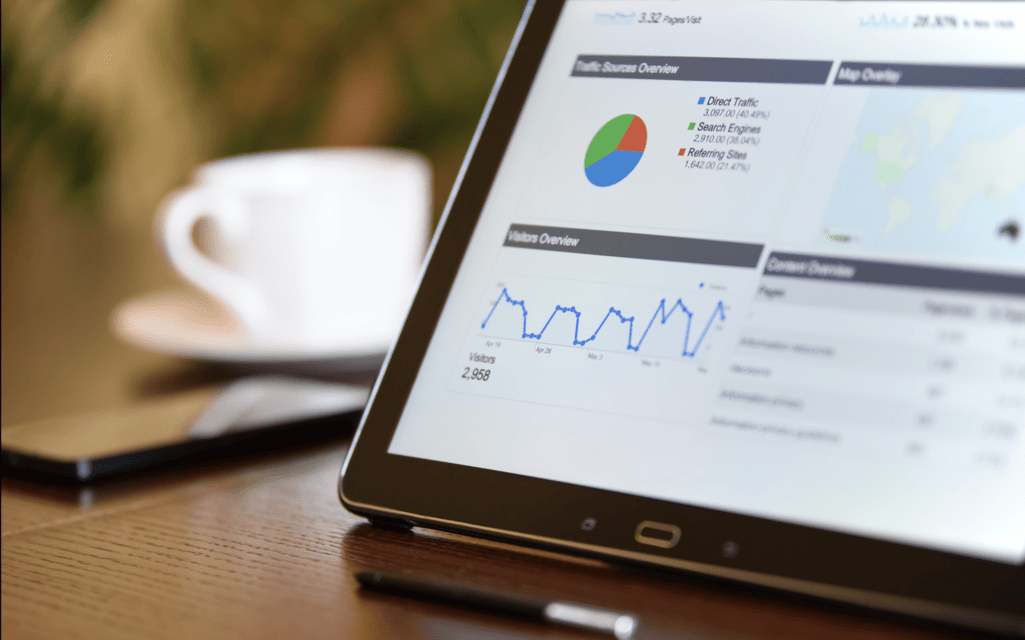Build your customer referral program without the dev time
Sign up for a free trial of GrowSurf to lower your customer acquisition costs, increase customer loyalty, and save gobs of time.
Launch Your ProgramImage source: "A Group of People Discussing Charts", by Mikael Blomkvist, licensed under Free to Use
Digital marketing is a fast-paced industry where you can’t afford to stand still.
Reaching your target audience and increasing brand recognition is no longer the only KPIs you need to track.
Now, as marketers spend more time focusing on digital marketing and its potential ROI, the focus has shifted from pure volume metrics to measurable performance indicators that allow us to assess the effectiveness of our strategies.
This blog post outlines 17 of the most important digital marketing KPIs for measuring your success. We divided them into five separate categories to make it easier for you to follow along.
Let's dive in!

Image source: "A Person Using a Calculator", by Vlada Karpovich, licensed under Free to Use
To calculate CAC, add up all the costs associated with acquiring new customers and divide that amount by the number of customers you acquired. This is usually calculated for a specific time range. CAC takes into account the total marketing expenses of acquiring a new customer, including wages for employees involved in the sales process, marketing materials and salaries for marketing personnel, and other related costs.
Customer Acquisition Cost Formula:
Sales + marketing expenses / number of customers acquired = CAC
To calculate CLTV, you must first calculate customer value and average lifespan. To calculate customer value, take your average sale price and multiply it by the number of purchases an average customer makes. Let's say that your average sale price is $200. The typical customer will purchase your product three times on average. Your customer value is $600. Calculate customer lifespan by averaging the number of years a customer stays a customer. To calculate the CLTV, you need to multiply the average customer lifespan by customer value.
Customer Lifetime Value Formula:
Customer value X average customer lifespan = CLTV
Return on investment (ROI) is a KPI that shows the financial benefits of a particular strategy or campaign. ROI is calculated by taking the amount of money spent on a particular strategy and dividing it by the total revenue that strategy contributed to the company. For example, a company spends $100,000 on a marketing campaign and generates $200,000 in revenue. The company’s return on investment is $200,000/$100,000, which is 2x. This can be helpful when trying to determine which marketing strategies, channels, and campaigns give the most bang for your buck.
Return on Investment Formula:
Net Profit / Cost of Investment = ROI
Conversion rates are one of the most basic digital marketing KPIs. Essentially, it's the rate at which people visit your website or follow through with an action you want them to take (like signing up for a newsletter). Conversion rates are calculated as the number of conversions divided by the number of total site visits. For example, you have a website that gets 1,000 visitors per day. Out of those 1,000 visitors, 100 people sign up for your newsletter. That means your conversion rate is 10% or 100 visitors for every 1,000 who visit your site. On average, conversion rates can vary widely from industry to industry. Some industries have seen an increase in conversion rates over the past few years, while others have seen a decrease.
Conversion rate formula:
Conversion rate = conversions / total visitors * 100%

Image source: "Black Samsung Tablet Computer", by PhotoMIX Company, licensed under Free to Use
When you track search traffic, you’re measuring the number of visitors coming to your site from Google and other search engines. Search traffic metrics include the total number of visits, organic traffic, unique visitors, traffic sources, top visited pages, page views per session, and other KPIs.
One of the most important aspects of SEO is tracking keyword rankings, i.e., how well your website ranks for a given keyword. By tracking rankings, you can see how well your website performs against other websites using the same keywords. In addition, tracking rankings can help you to understand whether or not your website is performing optimally.
To track keyword rankings, you need to measure keyword performance. There are several different ways to measure keyword performance, but the most common methods are:
A great way to get an overall view of your keyword rankings is through a tool like SEMrush or Ahrefs. It gives you an overview of your keywords, rankings, and average monthly search volume. You can also track your average keyword ranking over time to see if you're seeing an increase or a decrease in your brand's presence on the web.
Backlinks are links on other websites that are linking to your website. As one of the more complicated digital marketing KPIs to track, backlinks can increase your Domain and Page Authority if they're coming from high-quality sites. Similarly, they can negatively affect your rankings if you have links that come from not-so-trusted websites. It's essential to track the number of backlinks you have to see how those links affect your rankings and traffic.
A high bounce rate is usually associated with things like slow site speed, misleading title tags and/or meta descriptions, bad links from other websites, technical errors, low-quality content, and more. The bounce rate is calculated by taking the total number of visitors to your site and dividing that number by the number of people who viewed only one page (their entrance or exit page). You can easily track your bounce rate through platforms like Google Analytics or SemRush. This metric helps determine where to focus your efforts. If your bounce rate is high, you may need to conduct a website audit and make significant changes.
Page Authority is a metric that evaluates how well a page ranks in the search engine results pages. It's determined by several factors, such as how often your content is visited, how often it is being shared, how many backlinks the page has, and more. Domain Authority is similar to page authority, but it considers how well your entire website ranks in the SERPs. It is calculated based on various factors, such as your brand's relevance, website speed, the number of links pointing to your site, and the quality of your content. These metrics help determine the overall health of your website and how well it's ranking in search.

Image source: "Macbook Air on Grey Wooden Table", by Caio, licensed under Free to Use
Cost-per-click (CPC) is a metric that measures how much you pay for the ads you place on websites or social media based on the number of clicks the ad receives. You must track your CPC rate, as it measures the price your brand will spend on advertising campaigns if you want to stay profitable. A high number of clicks, or visits on an ad, means that the ad is getting attention from customers. The more in-demand a keyword is in the auction, the higher the advertising costs. If you want to see the best results with your campaign, you need to keep your CPC low.
CPC Formula:
Total CPC / Total Clicks = Average CPC
Click-through rate (CTR) is an important metric to track because it tells you how many people are clicking on your ads after they appear on search engines. Optimizing your ads or refining your audience is generally a good idea if your CTR is low. To do so, try adjusting your ad copy and/or keywords, or consider altering your bidding strategy. If you see a spike in CTR, it could be a sign that your ads are resonating with people, and identify what you're doing well so you can recreate it with future ads. You can calculate your CTR if you divide the number of clicks that your ad receives by the number of times your ad is shown. Let's say you had ten clicks and 100 impressions. In this case, your CTR would be 10%.
CTR Formula:
The number of clicks / the number of times your ad is shown = CTR
Quality Score is a metric you should be closely tracking if you're managing a paid search campaign. It's an important indicator of how well your ads are performing compared to other advertisers, and it can help you to boost your overall click-through rate (CTR) and conversion rate if managed correctly. Google determines Quality Score based on the combined performance of three components: your CTR, ad relevance, and landing page experience. By measuring your Quality Score, you can identify room for improvement in terms of keyword selection, landing pages, and ads. You can easily view your Quality Score in your Google Ads account.

Image source: "Black and Gray Digital Device", by Torsten Dettlaff, licensed under Free to Use
Email signups are a good way to measure the success of your email marketing strategy. The email signup rate is the number of people who sign up for your email list divided by the number of visitors to your website. For example, if you have 10,000 monthly website visitors and 50 of them sign up for your email list, your email signup rate is 0,5%. Your email signup rate is a good indication of how successful your email marketing efforts are. Subscribing to an email list is optional, so you should entice site visitors to sign up with incentives like free guides, white papers, discount codes, premium content, etc.
Email open rate is the percentage of people who opened your email out of the total number of people who received the email. For example, let's say you sent an email to your 1,000 subscribers, and 200 of them opened your email. This means your average open rate is 20%. To determine whether your email marketing efforts are yielding results, you should track how your email open rates are improving over time. At the same time, you'll be able to identify what type of content your subscribers are most interested in reading. You should also test different email subject lines and preheader text to see what technique yields the best open rate.
Email click-through rate is the percentage of people who clicked on at least one link in your email. If you want to calculate your email CTR, simply divide the number of people who clicked by the number of delivered emails and multiply that ratio by 100. Make sure you track your email CTR in combination with your open rate to pinpoint what you're doing well and what you're doing wrong.
An unsubscribe rate measures the percentage of users who have opted out of the mailing list after an email campaign. Your unsubscribe rate is calculated by dividing the number of unsubscribes by the number of emails delivered. For example, let's say you sent out 2,000 emails in your latest email campaign, and 20 people have opted out. Your unsubscribe rate is 1%.

Image source: "Women Smiling while Looking at the Smartphone", by Antonius Ferret, licensed under Free to Use
We have our own referral calculator that can be used to help you calculate your ROI, along with your customer acquisition cost (CAC) and net new business.
The ROI formula is based on four pieces of information:
For example, let's say that your CLV is $1,000. You're willing to spend $100 on referral program rewards, and on average, you get ten referrals per month.
In less than one second, you'll be presented with the following calculations:
Try our ROI calculator here!
In this post, we only scratched the surface of the most important digital marketing metrics you should track to measure the health of your marketing efforts. There are many more that we didn't even get to mention, such as Monthly new leads, Qualified leads per month, Visits per channel, Leads and conversions from social media, and more. Make sure you get acquainted with the most important metrics and carefully choose which ones you will track. Choosing the right metrics to track your progress is critical when launching a new ad, SEO, or email campaign. Measure these metrics on a monthly basis to identify room for improvement and beat your competitors.

Sign up for a free trial of GrowSurf to lower your customer acquisition costs, increase customer loyalty, and save gobs of time.
Launch Your Program
GrowSurf is modern referral program software that helps product and marketing teams launch an in-product customer referral program in days, not weeks. Start your free trial today.
Marketers face lofty expectations. Yet with the right goals in place, marketers are well-equipped to achieve the optimal results.
There is no "best" referral marketing strategy: You need to personalize your approach to fit your audience! Here's 10 ways to improve your referral strategy.
Although customer experience is most often used as a tool for improving retention, did you know customer experience boosts customer acquisition too? Here's how.
SaaS pricing can be one of the most challenging parts of operating a software company. Here is a breakdown of how to make a successful SaaS pricing strategy.
Are you looking for guerrilla marketing ideas to excite your imagination? We have 10 real-life examples that can inspire your next profit-making campaign.